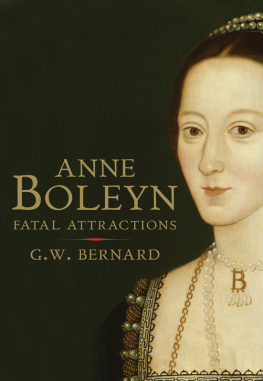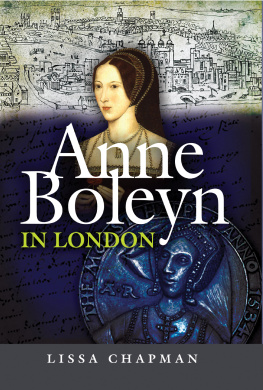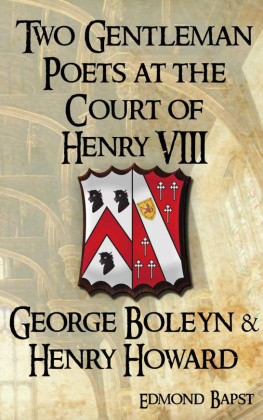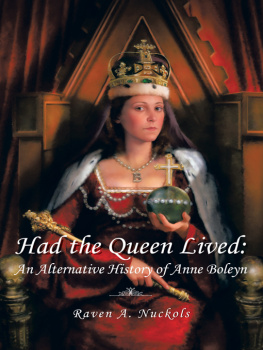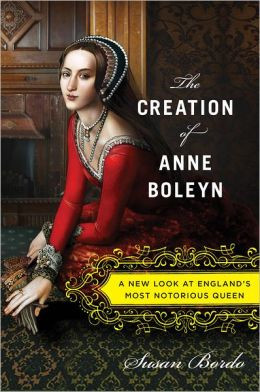ANNE BOLEYN
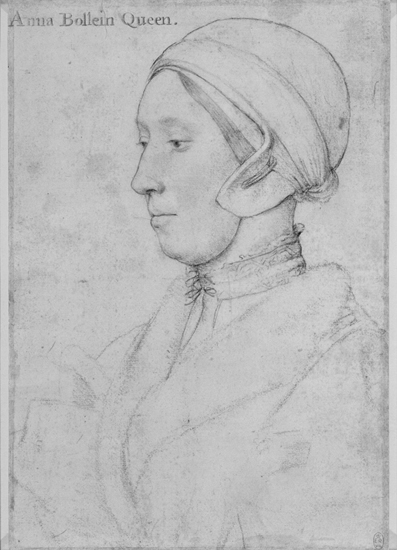
ANNE
B OLEYN
FATAL ATTRACTIONS
G.W. BERNARD
YALE UNIVERSITY PRESS
NEW HAVEN AND LONDON
Published with assistance from the foundation established in memory of Oliver Baty Cunningham of the Class of 1917, Yale College.
Copyright 2010 G.W. Bernard
All rights reserved. This book may not be reproduced in whole or in part, in any form (beyond that copying permitted by Sections 107 and 108 of the U.S. Copyright Law and except by reviewers for the public press) without permission from the publishers.
For information about this and other Yale University Press publications, please contact:
U.S. Office: sales.press@yale.edu www.yalebooks.com
Europe Office: sales@yaleup.co.uk www.yaleup.co.uk
Set in Sabon by IDSUK (DataConnection) Ltd
Printed in Great Britain by TJ International Ltd, Padstow, Cornwall
Library of Congress Cataloging-in-Publication Data
Bernard, G.W.
Anne Boleyn/George Bernard.
p. cm.
Includes bibliographical references.
ISBN 978-0-300-16245-5 (cloth: alk. paper)
1. Anne Boleyn, Queen, consort of Henry VIII, King of England, 1501?1536. 2. QueensEnglandBiography. 3. Great BritainHistoryHenry VIII, 15091547Biography. 4. Great BritainKings and rulersBiography. 5. Henry VIII, King of England, 14911547Marriage. I. Title.
DA333.B6B45 2010
942.05'2092dc22
[B] 2009039203
A catalogue record is available for this book from the British Library
10 9 8 7 6 5 4 3 2 1
C ONTENTS
P REFACE
M ost of us acquire our first historical impressions at an early age from some vivid story or image. We learn about Alfred burning the cakes, for example, about the bloodthirsty and feuding medieval nobility, about the ignorance and immorality of the monks and clergy of the later Middle Agesand about Bluff King Hal, about Henry VIIIs lustful pursuit of a dazzling succession of court ladies. Such images are powerful, leaving a lasting impact. Many of us go on to read historical novels or watch historical films and plays, and acquire what seem clear and utterly persuasive views of the past. Many have come across Anne Boleyn in novels and films and have greatly enjoyed the ways in which their writers and directors have told her story.
But a professional historiansomeone who studies and teaches history at universitywill want to warn you that matters are not quite so straightforward. My interest in Anne Boleyn began in much the same way as anyone elses: I was intrigued by the remarkable and dramatic events that led to Henry VIIIs break with Rome, by Annes part in them, and then by her extraordinary downfall. But as a professional historian I wanted to test what I had been told. Those powerful images of Anne that we have seen in films or read in novels may well not be the whole story. On what are they based? How can we know that they are true?
Prompted by such curiosity, I set off on a voyage of discovery shared with you here. It may well be that the destination turns out to be rather different from that which you expect. Not the least of the challenges is that there is rather less evidence surviving from the early sixteenth century than one would wish. I should emphasise that much must unavoidably remain uncertain. In Green Road, East Ham, just along from West Ham football stadium, the Boleyn ground, are the Boleyn pub, built in 1898, and the Boleyn cinema, built in 1938. They are called after Anne Boleyn because there was once (as illustrations show) a Tudor brick house with typical chimneys here. It was owned by Richard Breame, a minor servant of Henry VIII. And, so the story goes, this was one of the places which Henry visited when courting Anne. There is no surviving evidence to that effect; it is not impossible; but we lack anything like proof.
The greatest shortcoming of the surviving sources is that we are short of information about what people thought and why they did what they did. Consequently a good deal must be inferred from actions: a reasonable proceeding, but one to be undertaken carefully and openly. Historical playwrights, historical novelists and film directors are perfectly free to use their imaginations to fill in the enormous gaps in our knowledge, and if they do so to dramatic effect, that undoubtedly makes for good reading and viewing. But precisely because such representations can be powerful and make a deep impact, they risk embedding images that are at best fanciful and at worst downright false. My approach is rather to ask questions at every turn, always to show where our information comes from, whether from a letter written by Anne herself (though there are very few of those) or from a despatch by one of the foreign ambassadors in England (notably Eustace Chapuys, the imperial ambassador from 1529), or from a near-contemporary narrative history (such as those of George Cavendish, sometime servant and then biographer of Thomas Wolsey, or of the martyrologist John Foxe) and to share with you my reasoning, and indeed my speculation, albeit I hope informed speculation, on matters on which the evidence alone is tantalisingly inconclusive or frustratingly absent.
A CKNOWLEDGEMENTS
I t was in the middle of a class on the politics of Henry VIIIs reign that it first occurred to me that Anne Boleyn might not have been entirely innocent of the adulteries of which she was accused. And many generations of students have since discussed and argued with me about Anne Boleyns fate: I am greatly indebted to them. My late colleague T.B. Pugh supplied me with references and first encouraged me to go further. As I did so, in writing the articles in which I first sketched my claims (for permission to draw on which I thank Oxford Journals and Cambridge University Press) and more recently in preparing this biography, I benefited from the advice and the questioning of many friends, including Cliff Davies, the late Jennifer Loach, Penry Williams, Peter Gwyn, Jenny Wormald, Steve Gunn, Greg Walker, David Katz, the late Geoff Dickens, Rhys Robinson, Henry James, Wendy Toulson, Edward Wilson, Mark Stoyle, Janet Dickinson, Anne Curry and John Painter. Both Peter Gwyn and Mark Stoyle are due special thanks for undertaking the labour of reading and commenting on successive drafts. At Yale University Press, I specially wish to thank Robert Baldock, Tom Buhler and Beth Humphries. The British Academy and the University of Southampton financed research in the Haus-, Hof- und Staatsarchiv, Vienna: I am very grateful to the staff there for their most helpful assistance. An award by the Arts and Humanities Research Council doubled the study leave given me by my own university and so enabled me to complete this study.
1
These bloody days have broken my heart
THE FALL OF A NNE B OLEYN
O n 30 April 1536 Mark Smeaton, a musician at Henry VIIIs court, was arrested and interrogated. Maybe he was tortured. George Constantyne, himself suspected of treason when testifying three years later, declared that the saying was that he was first grievously racked, but immediately added the qualification, which I could never know of a truth. Tortured or not, Mark confessed that he had on three occasions made love to Anne Boleyn, Henry VIIIs queen. That, quite understandably, was enough to send him to the Tower. The arrests did not end there. Henry Norris, chief gentleman of Henrys privy chamber, the closest of the kings personal servants, was sent to join Smeaton in the Tower, after Henry VIII had personally interrogated him the following day. Anne Boleyn followed, after she had been interrogated by the kings council, together with her brother, George, Viscount Rochford. Several courtiers were sent there too: William Brereton and Sir Francis Weston, both gentlemen of the privy chamber, the poet Sir Thomas Wyatt, and Sir Richard Page, another courtier. Wyatt and Page were shortly set free. But Anne, her brother, Smeaton, Norris, Brereton and Weston were all indicted.
Next page
